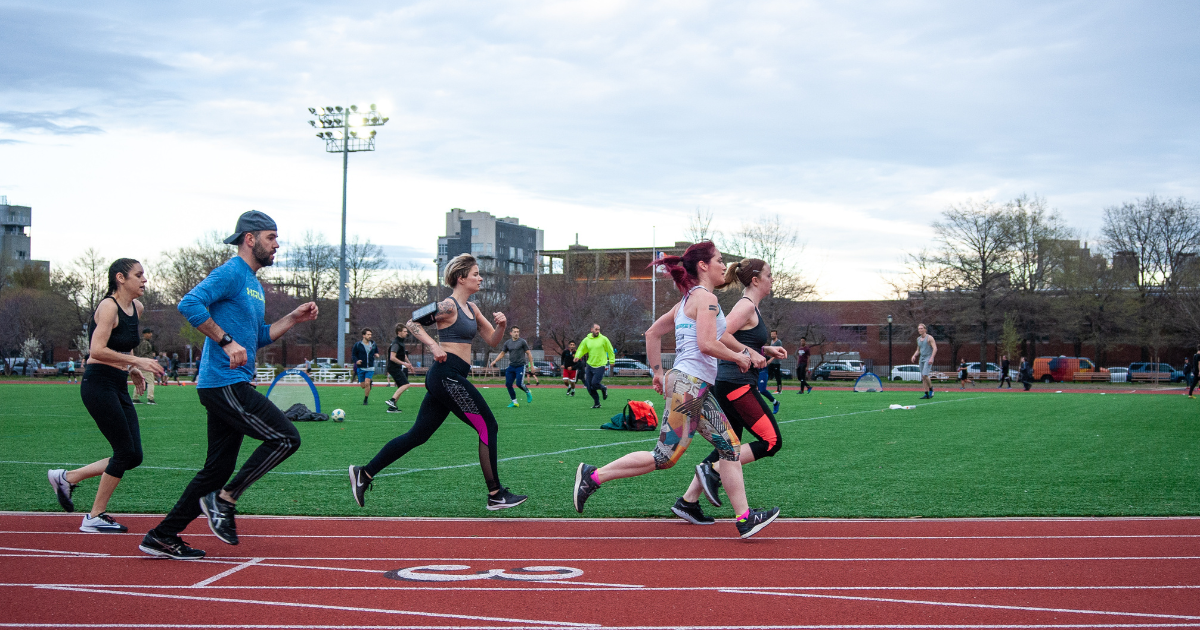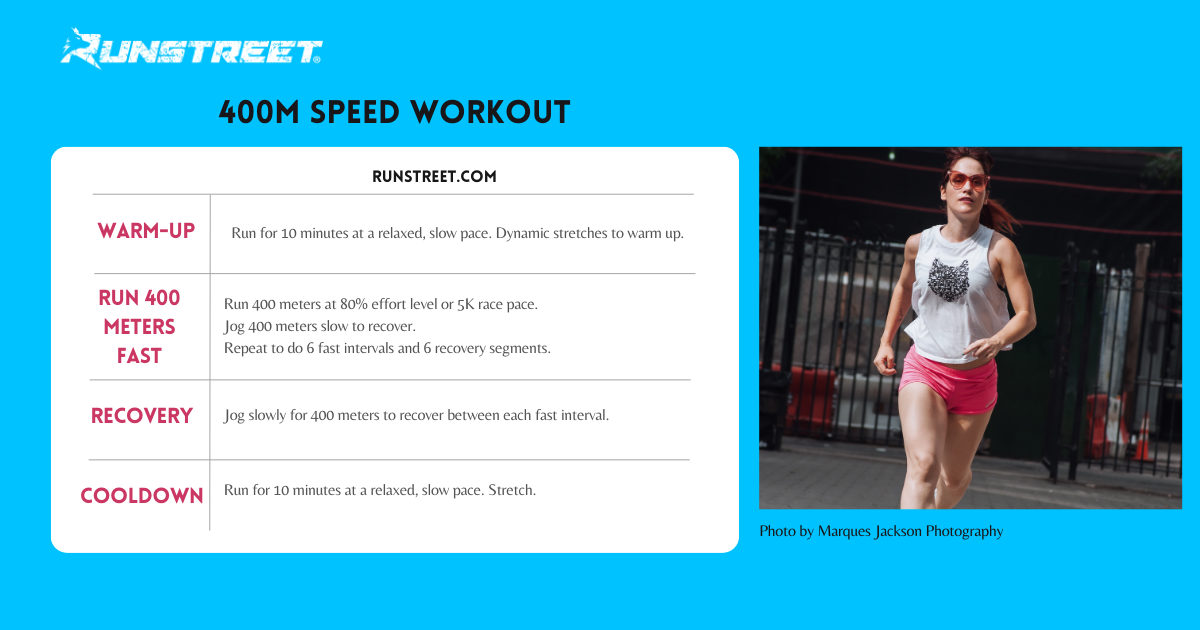Interval Training for Beginners with Sample Workout
Runstreet track photos by Marques Jackson Photography.
By Marnie Kunz,
certified trainer and run coach
Interval training for beginners is the key to becoming a faster, better runner. Whether you’re new to running or are a seasoned marathon runner, intervals can help you get faster, improve your race times, and boost your overall fitness level. Also, if you are running to lose weight, high-intensity intervals burn more calories than slow running and will help boost your metabolism. This guide will explain more about interval training and offer my top workouts as a running coach and personal trainer.
Getting Started with Interval Training
Oftentimes, beginning runners think that if they run the same speed and distance every day, they will keep improving. But the truth is, you will plateau and stay at the same running level if you don’t push yourself. Interval running is a speed training technique that will help you break through your plateau and improve your cardio fitness and running speed.
Intervals are a great way to test your limits and improve your overall conditioning and speed. Interval training for beginners allows you to ease into interval training and build your speed and stamina gradually. Beginner runners can add short interval workouts to their routines to help meet their fitness goals and get faster.
What is Interval Training?
Interval training will make you a faster runner.
What is interval training, you may be wondering? Interval training is a workout that involves bursts of intense effort followed by periods of recovery. For runners, this translates to measured amounts of fast running with periods of slow recovery jogging (or walking). Usually, beginners should do high-intensity exercise like intervals in a short amount of time, and gradually increase the duration or repetitions of the fast intervals.
You can start adding interval workouts to your running program after you have been doing at least 4 to 6 weeks of consistent base runs. Base runs are relaxed pace runs that build your overall endurance and fitness level. They are steady state runs at a conversational pace, where your heart rate is usually 60 to 70 percent of max heart rate, in Zone 2.
Related Post: How to Do Base Runs
Benefits of Interval Training
There are many benefits of interval training for beginners. From a health perspective, interval training is great for strengthening your heart and lungs and for meeting your exercise requirements in an efficient way.
The American Heart Association recommends getting at least 150 minutes per week of moderate-intensity aerobic activity or 75 minutes per week of vigorous aerobic activity. Interval training counts as vigorous exercise. So you can spend less time on your workouts while still getting great heart benefits.
Interval training is a form of speed workout, and speed workouts - as the name implies - help you become a faster runner. Intervals help train your body to perform during times of fatigue and oxygen deficit. This will improve your race performance and help you become a higher-level athlete.
If you want to get your best 5K time or PR in your next race, interval training will help get you there. Interval training also will improve your speed endurance, which means you will be able to run fast for longer segments. In addition, interval training will strengthen your legs, which is especially helpful when you are running up hills or feeling fatigued in tough workouts or races.
Interval training is a great way to step up your running program intensity and break through a fitness plateau. Many runners get stuck in a rut running the same pace and distances over and over, and this makes it hard to become a better runner.
Interval Training for Beginners
Try this fartleks workout based on time.
Sample Fartlek Workout
Fartleks is Swedish for "speed play." Fartleks are interval workouts that are beginner-friendly. The workout includes short bursts of speed mixed in with your regular, relaxed pace base run. Fartleks can be informal, such as picking a pole in the distance and running fast until you pass it, then returning to a low-intensity, relaxed pace.
For a more structured fartlek workout, try this:
Jog 800 meters (2 laps on an outdoor track or half of a mile) at a relaxed pace to warm up. Do dynamic stretches.
Run 400 meters (one lap or .25 of a mile) at a relaxed, base run pace.
Run 100 meters (one straight side of a track or .062 of a mile) at 90% effort level.
Repeat to do 3 fast runs and 3 regular paced runs.
Cool down by running 800 meters slowly. Stretch.
Related Post: Fartleks Workouts to Help You Run Faster
Sample 400-Meter Interval Workout
Here’s how to do a beginning running interval training workout:
Try this 400-meter speed workout to get faster.
Begin with a shorter number of intervals and add more intervals over time.
0.5-mile warm-up. Run slowly for a half-mile (800 meters or two laps around a standard outdoor track) to warm up. This run should be at a relaxed pace, one at which you could keep up a conversation.
Stretch and do drills. Take 10 minutes to do dynamic stretches to get your muscles warmed up for fast running. This will reduce your chance of injury.
Run 400 meters at your goal 5K pace (.25 of a mile on the road or one lap on a standard running track). You can calculate your goal 5K mile pace and then divide the mile time by 4 to get your 400-meter pace. For instance, if your 5K goal is to run 10-minute miles, one-fourth of that is 2:30 so 2:30 should be your goal 400 pace. If you do not have a goal 5K pace, aim for running at 80% of your maximum effort level. You will feel winded and challenged but you should be able to maintain the same pace for each interval.
Recover for 400 meters. Jog slowly for one lap (or .25) for active recovery.
Repeat the run-recovery cycle for a total of 4 fast spurts and 4 recovery laps (4 x 400 fast and 4 X 400 at slow, recovery speed). This equals 1 mile of intense running and one mile of recovery.
0.5 mile cool down. Run slowly for a half-mile to cool down. This run should be at a relaxed pace, one at which you could keep up a conversation.
Stretch and do drills. Take 10 minutes to stretch.
Rest and rehydrate. It is important to do an easy run the day after a speed workout or take a rest day. Also, rehydrate for optimal muscle recovery.
Interval Workout Variations
You can modify this workout to meet the demands of your training program. If you are training to run a half marathon or marathon, for instance, you can increase your interval distance (and recovery distance) to 800-meter (half-mile) intervals.
You can also increase your interval amount over time as you build endurance. After two weeks of doing 4 intervals, for example, you can add one more to do 5 intervals. Marathon runners can build up to running ten 800-meter intervals for speed training.
Related Post: For a great 800-meter interval workout, see How to Do Yasso 800s.
How Often to Do Interval Workouts
I recommend doing speed workouts twice a week, or a minimum of once a week, if you want to get faster and improve your running performance. In addition to intervals, tempo runs are another great speed workout you can add to your training plan to get faster, especially for long-distance races such as half marathons and marathons.
Remember to follow the easy-hard training principle and do easy workouts or recovery days before and following speed workouts. Speed workouts, long runs and races are considered hard training days so you will need a recovery or rest day after doing them.
If you need help figuring out the best speed workouts and paces to do, I offer a customized running training plan to help you crush your running and race goals.
Have you tried this interval workout? Follow and tag @Runstreet Instagram in your running posts and I will cheer you on. Happy running to you!😊
Related Posts: Get Faster with Tempo Runs, 3 Track Workouts to Improve Your Race Times, How to Do Yasso 800s
Marnie Kunz is a NASM-certified trainer and USATF- and RRCA-certified running coach, a dog lover, an Akita mom, and the founder of Runstreet. She specializes in helping runners get faster and stronger and helping beginners elevate their fitness levels. She is based in Brooklyn, New York.






